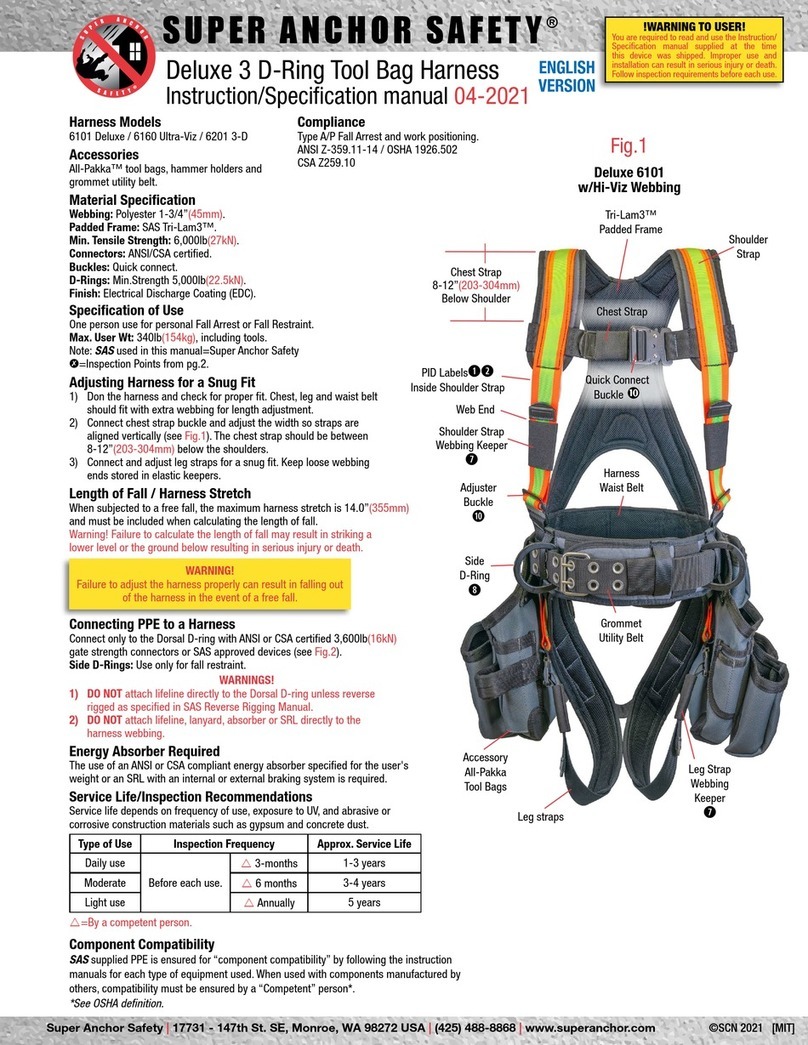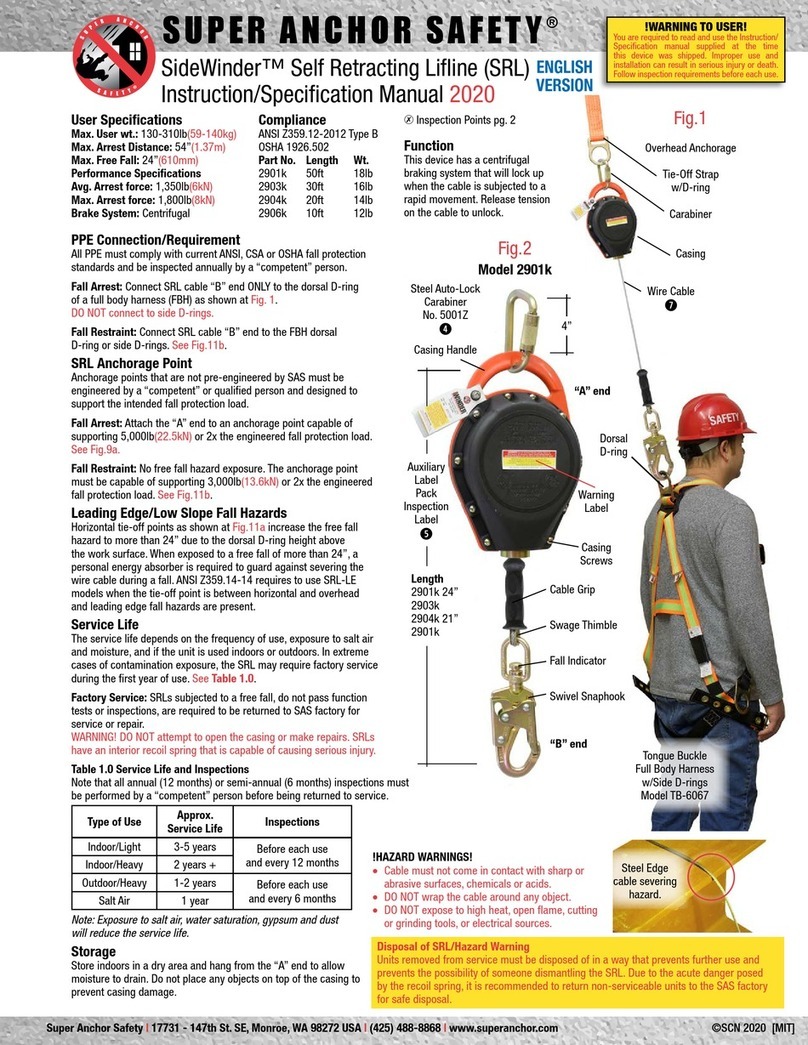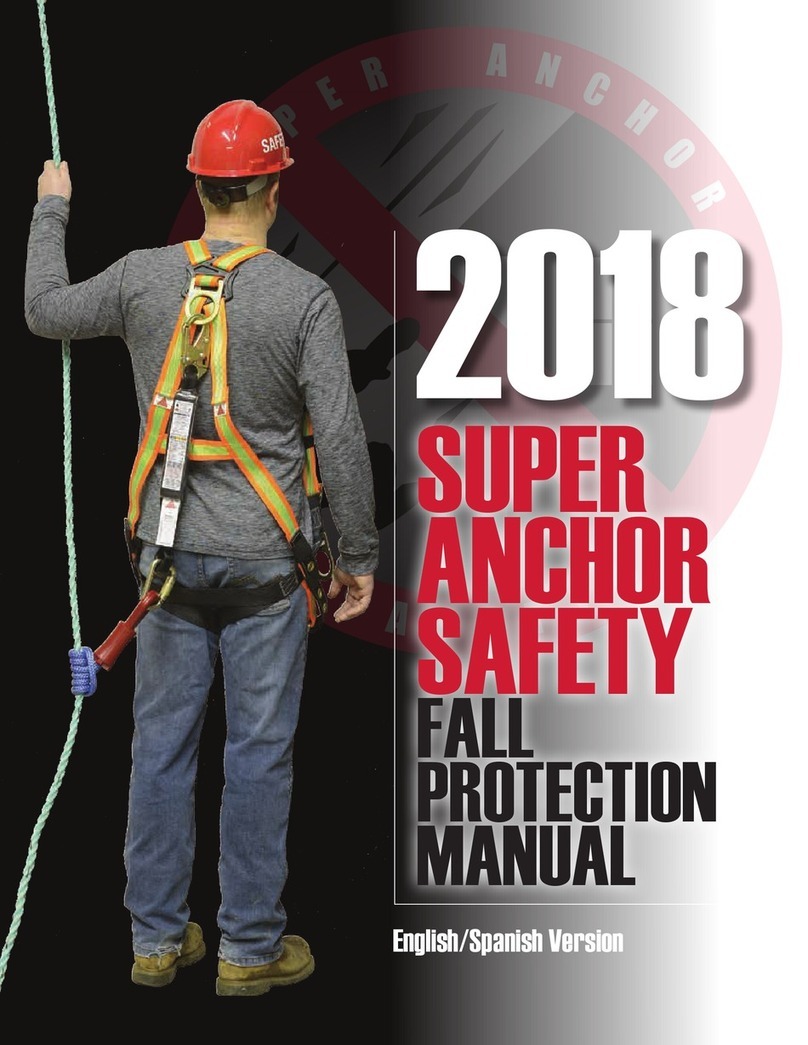
WARNING!
Attach leg to framing with 3ea
2” length Super Anchor supplied WS
wood screws only. DO NOT substitute
with other fasteners.
DO NOT USE NAILS
¡ADVERTENCIA!
Sujete la pierna al enmarcado
con 3ea tornillos de series WS
para madera de 2” de longitud
suministrados por Super Anchor
solamente. NO sustituya con otros
sujetadores. NO USE CLAVOS.
Label: WS Truss Bar 1.1 Eng/SP ©SCN 01-2018 Template TRB 3.1
Super Anchor Safety®
Monroe, WA 98272 USA
WS Truss-Bar™ No. 2835
Material: 6mm 5052 grade Aluminum
Min. breaking strength: 5,000lb
Resistencia minima de rotura: (22.5kN)
Cross-Bar Bolts: 12mm X 1-1/4”-316sst
Compliance: Cumplimiento:
OSHA 1926:502/1910.66
ANSI Z359.1-07/A10.32-2012
WARNING: Before use read the instruction manual
included with this anchor at time of shipping.
User Specifications: One person max wt. 340lb
Max Free Fall Length: 6ft.Max Arrest Force:1,800lb
PPE Attachment: Personal energy absorber required.
2 Anchors May be used for a Horizontal Lifeline System.
FASTENERS: Use SAS factory supplied WS Screws only.
Do not substitute with others types. DO NOT USE nails.
Requires 3ea WS 2.0” length screws in each leg.
REMOVE FROM SERVICE: If anchor is subjected to a fall
or other force or evidence of damage to legs or cross-bar
Framing: Attach to fully sheathed min. 2x4 top chord that
is capable of withstanding 2x the max. fall arrest force.
ADVERTENCIA: Antes de usar, lea el manual
de instrucciones suministrado con el envío de esta ancla.
Especificaciones para el usuario: Una persona, peso máximo 340lb
Máxima longitud de caída libre: 6ft.Fuerza máxima de arresto:1,800lb
Equipo PPE: Se requiere componente de amortiguador personal.
Se pueden usar 2 anclas para el sistema de Cuerdas Salvavidas Horizontales (HLL).
SUJETADORES: Use solamente tornillos de series WS suministrados por la fábrica SAS.
No sustituya con otros tipos de tornillos. NO USE clavos.
Se requiere 3ea tornillos de series WS de 2.0” de longitud en cada pierna.
RETIRE DE SERVICIO: Si el ancla se somete a una caída
u otra fuerza o evidencia de daño a las piernas o la barra transversal.
ENMARCADO: Sujete a la cuerda superior completamente enfundada
de mín. 2x4 que es capaz de aguantar 2x la fuerza máxima de arresto de caída.
Label: WS Truss Bar 1.0 Eng/SP
©SCN 01-2018 mfg. China
Label Template TRB 3.0
Standard Installation
Attached to top chords.
Belay Rigging Wrong
DO NOT attach to angle web.
Angle Web
Belay Rigging Correct
RS-10
WS-Screws
Steel Carabiner
Vertical Web
Attach RS-10 or Hinge anchor
to the vertical web only with
6pc WS-2.0” or 2.5” screws.
Belay Rigging Example
Using an interim anchor point
attached to a truss web will
reduce the swing fall length.
Optional WS-TrussBar
attachment locations
Drywall Ceiling
Compatible Connection Examples
Single SRL w/Carabiner Single or Double HLL Single Lifeline Only No.1065-AC Coil Absorber
When 2 HLL are used in series only 1 person
may be attached to 1 leg of a HLL at one time
or 1 person each leg.
Leg 1 Leg 2 For use with 5º HLL systems,
1 absorber is required for each HLL leg.
Leg= 2 anchor ends with
a single cable.
Multiple Lifelines
2 lines may be attached if they are used
for relay by 1 person only.
Relay is when 1 person uses 2 lifelines or SRL’s to
facilitate movement without changing anchor points.
Truss Chord Butt Splice
DO NOT attach the WS-TrussBar
or belay anchors to chord splices.
Product I.D (PID) and Warning Labels
Warning Label attached to each leg.
PID Label
Maintenance/Inspection
Inspect before each use and remove from service
if any of the following conditions are present:
Friction washers or lock nuts are missing.
Request replacement parts.
Leg Flange weld is cracked. Cross-bar or legs
are damaged or deformed.
Connector hole is cracked, cut or deformed.
PID/Warning labels are missing.
Request replacement labels.
5ea WS screws in each anchor leg.
DO NOT store materials or tools on top of the
WS-TrussBar. Store inside when not in use.
DO NOT allow the bar to come in contact with
electrical lines.
Removal From Service: Dispose of in a way
that prevents further use. It is recommended to
cut off the connector hole and disassemble.
PPE Attachments
Harness Dorsal
D-Ring
Extender Lanyard
No. 6002
Extender Lanyard
No. 6002-C
w/Carabiner
SRL’s
Sidewinder™
Fig.13.0
Fig.15.0
Fig.16.0
Fig.17.0 Fig.17.1 Fig.17.2
Fig.16.1
Fig.16.2
Fig.15.1 Fig.15.2 Fig.15.3
Fig.14.0 Fig.14.1
Fig.14.2
WARNING!
DO NOT allow a lifeline, lanyard,
HLL or SRL cable to cross over
the top of the WS-TrussBar.
Vertical Web
SUPER ANCHOR SAFETY®Page 4English Version
©SCN 2022 [MIT]
WS-TrussBar English Manual 05-2022




























